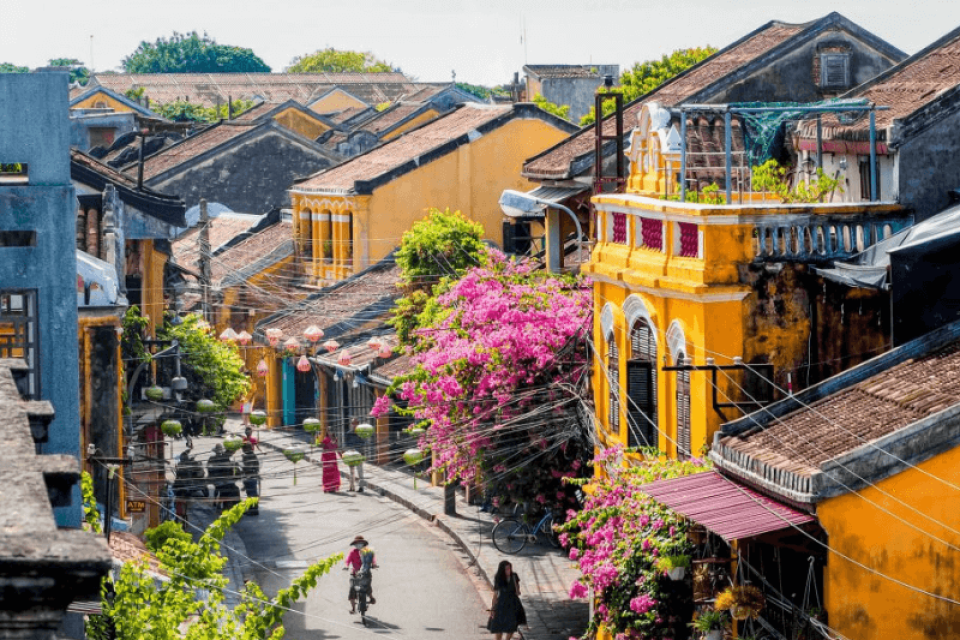Hoi An or Hue: Which one should you go to and why?
When it comes to traveling to Central Vietnam, many tourists are confused about whether to choose Hoi An or Hue for their journey of discovery. Both destinations are cultural and historical symbols, bearing the unique characteristics of the country and people of Vietnam. So should you choose Hoi An or Hue for your upcoming trip? Let’s find out and compare to have the most perfect choice!
Overview of Hoi An and Hue
Hoi An and Hue are two prominent destinations in Central Vietnam, offering distinct experiences in culture, history and landscape. With a distance of only 130 km, both cities are great choices for trips from North to South or vice versa, especially suitable for those who want to explore the unique beauty of the Central region. However, each city has its own characteristics, making tourists sometimes wonder: Should I choose Hoi An or Hue for my trip?
About Hoi An
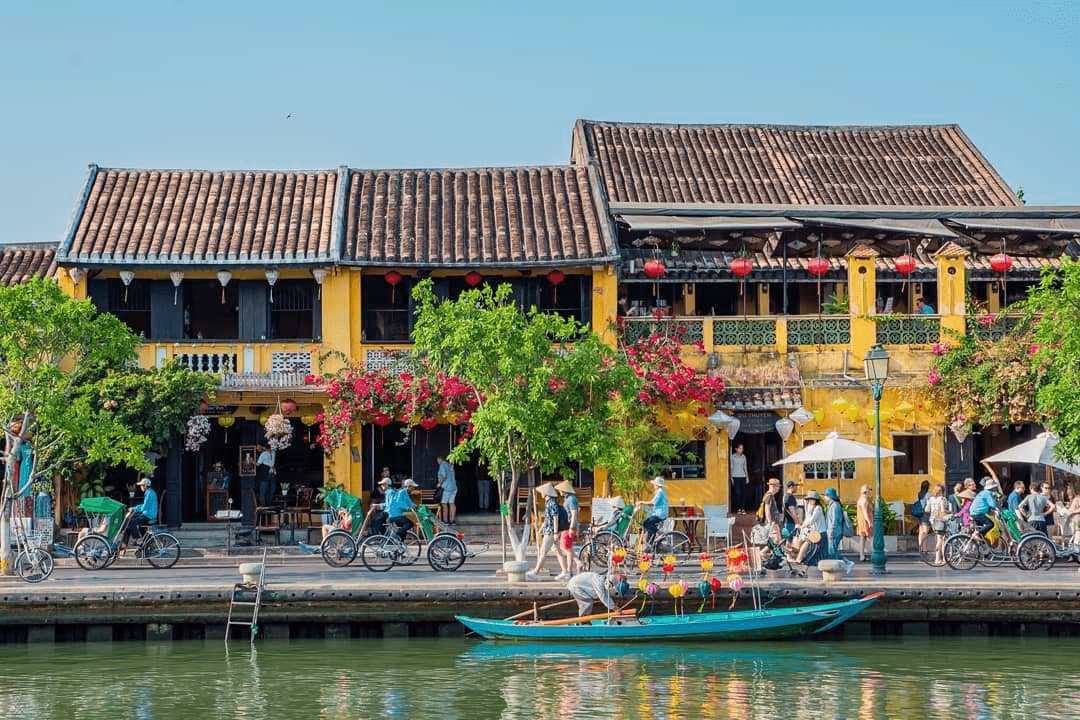
Located on the banks of the Thu Bon River, Hoi An is a historic port town with a peaceful and ancient beauty. About a 45-minute drive from the center of Da Nang city, Hoi An attracts visitors with its traditional beauty preserved through rows of ancient houses, shimmering lantern streets and quiet space. Hoi An is an ideal destination for those looking for relaxation and the charm of an ancient town.
About Hue
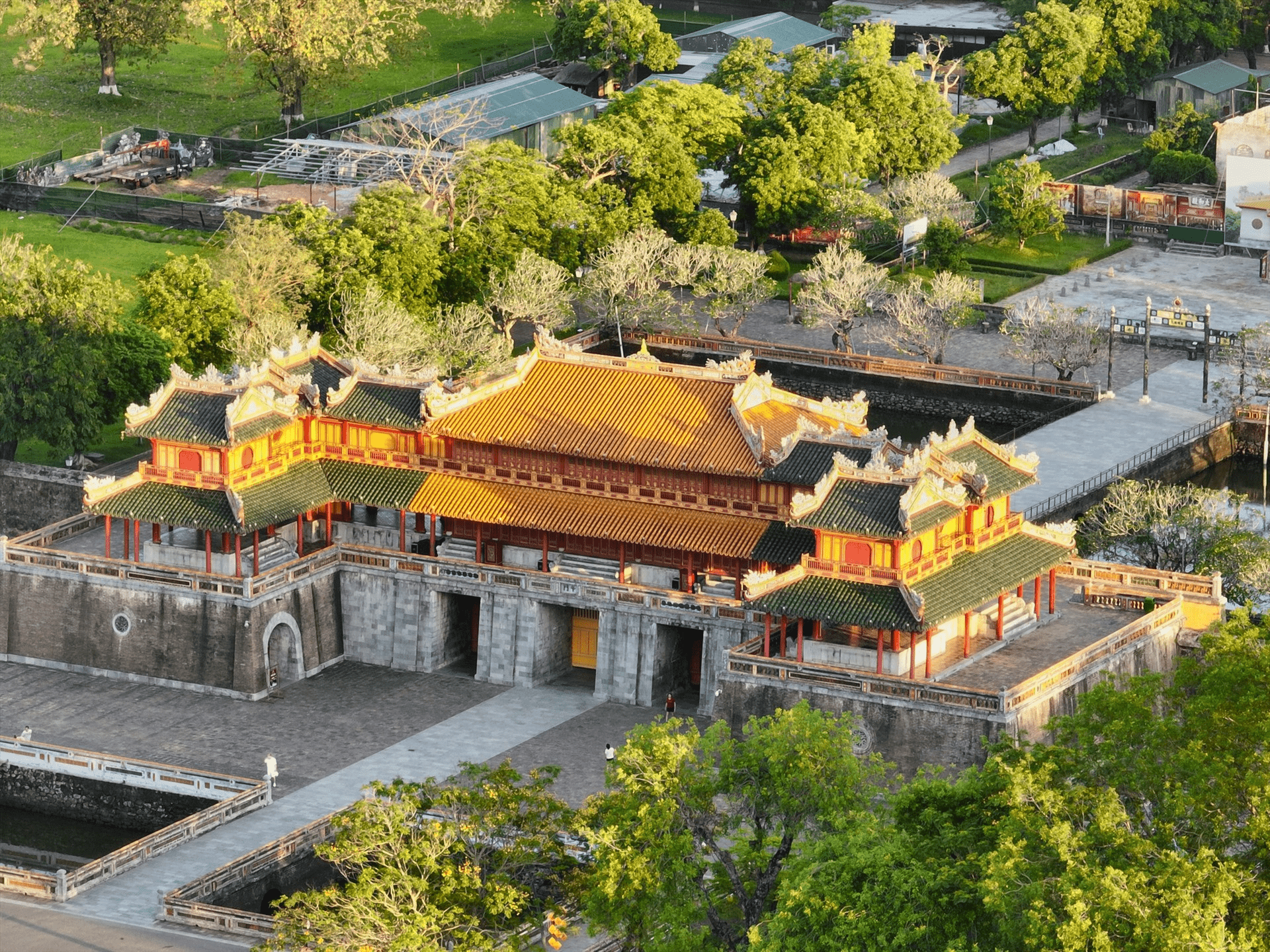
In contrast to the romance and tranquility of Hoi An, Hue has the quiet, ancient features of an ancient capital that was once the political and cultural center of Vietnam from 1802 to 1945. Located along the poetic Huong River, Hue is famous for its royal historical relics and the tombs of the Nguyen Dynasty kings, reflecting the golden age of the country. Architectural works such as Hue Citadel, Tu Duc Tomb, Minh Mang Tomb, and Khai Dinh Tomb are typical destinations, preserving the mark of the last dynasty in Vietnam’s feudal history.
Discover Hoi An – An ancient town with peaceful and romantic beauty
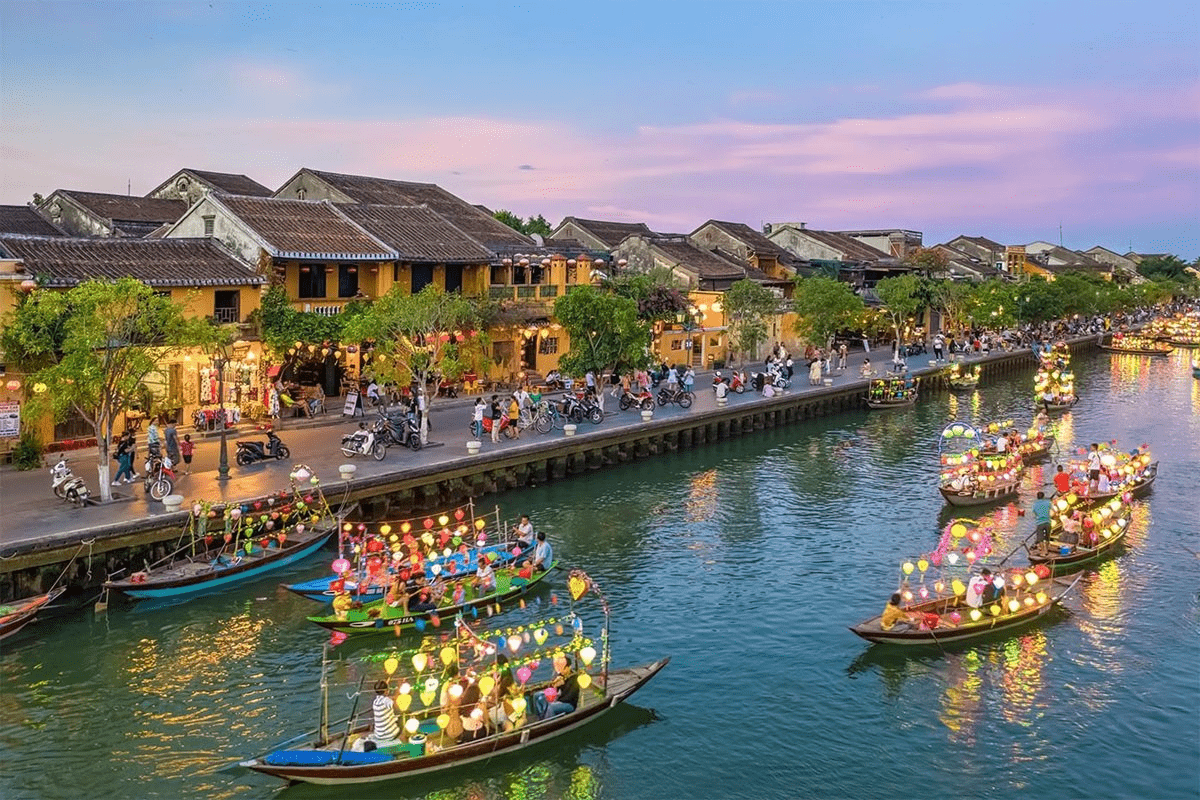
Hoi An, a small ancient town on the Thu Bon River, is an attractive destination for those who love peaceful, traditional spaces. This ancient city is not only famous for its sparkling lantern streets but also preserves unique cultural and culinary values, along with local experiences.
Distinctive architecture and landscape
Hoi An is likened to a fairy tale with traditional houses with tiled roofs, characteristic yellow walls and colorful lantern streets. The architecture here is a harmonious combination of Asian and European styles, with influences from Japanese, Chinese and French culture. Every street corner, every house carries within it the story of time and historical imprints, creating a space that is both familiar and new.
Hoi An at night is especially charming when the light from thousands of lanterns lights up, illuminating the quiet streets, creating a shimmering, magical scene. At night, the ancient town is quiet and poetic, without the sound of car horns, without the noise of modern life, only the gentle light from the lanterns, making visitors feel peaceful and relaxed.
Highlights in Hoi An
Hoi An has many attractive attractions that anyone who comes here cannot miss. The Japanese Covered Bridge is the symbol of Hoi An, the only ancient bridge built by the Japanese in the 17th century, which is both historically significant and a place for people to visit and pray for peace. In addition, the Phuc Kien Assembly Hall is a unique architectural work, with sophisticated carvings, a place of worship for the ancient Chinese community. The Sa Huynh Museum helps visitors better understand the culture and history of the ancient residents of Hoi An through valuable artifacts. The Lantern Street is where visitors can admire and take pictures with colorful lanterns, a typical symbol of Hoi An.
Hoi An’s signature cuisine
One of the things that attracts tourists to Hoi An is its unique and diverse cuisine. Hoi An is famous for its rich dishes, a blend of local culinary quintessence, and the creativity of the Hoi An people. Cao Lau, a typical noodle dish only available in Hoi An, is made from chewy noodles, delicious broth combined with pork, raw vegetables and crispy fried rice paper. Quang noodle is a rustic dish with rich broth, soft noodles and a variety of toppings such as shrimp, chicken, and quail eggs. In addition, Banh Bao Banh Vac – a small, delicious steamed cake, with a soft dough layer covering the meat or shrimp filling, is a dish that often appears in local people’s meals.
Hoi An is not only a place to enjoy traditional cuisine but also a place to experience the intersection between local cuisine and international styles. Visitors can easily find dishes that are varied, satisfying the tastes of many different cultures.
Must-try activities
One of the most interesting experiences in Hoi An is releasing flower lanterns on the Hoai River in the evening. Releasing each sparkling flower lantern on the quiet river, visitors not only feel relaxed but also send their wishes and good hopes.
In addition, Hoi An also has traditional craft villages that visitors can visit to better understand local life and culture. Thanh Ha pottery village is famous for its traditional pottery, visitors can visit and try making unique pottery items themselves. Tra Que vegetable village is where visitors can experience the work of growing vegetables, caring for and harvesting green vegetables, and enjoying dishes made from fresh vegetables in the garden. This is a viral activity for those who want to explore and experience the green, simple lifestyle of Hoi An people.
Hoi An offers visitors an ancient and romantic travel experience. With its sparkling lantern streets, unique cuisine, and rich experiences, Hoi An is an ideal destination for those who want to find a peaceful space and be close to nature and traditional culture. Come to Hoi An to feel the simple but charming beauty of this ancient town, and let the memories here become unforgettable marks on your journey.
Discover Hue – The ancient capital with profound historical and cultural beauty
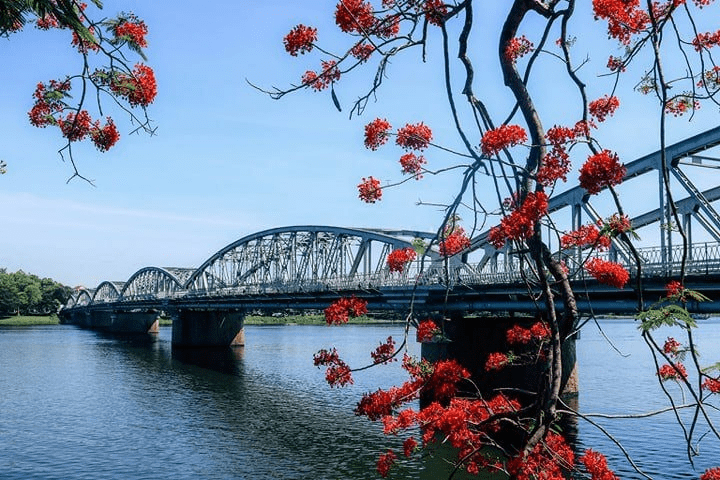
Hue, the ancient capital of Vietnam, is a place that preserves unique and profound historical and cultural imprints. Located on the peaceful Huong River, Hue was once the center of the Nguyen Dynasty and carries within it unique historical, artistic and royal cultural values. Visitors to Hue not only admire ancient architectural works but also have the opportunity to immerse themselves in the quiet, peaceful space of the ancient capital, where the past and present are charmingly intertwined.
Historical architectural works
Hue is famous for its system of royal relics built under the Nguyen Dynasty, from the beginning of the 19th century. Hue Citadel, the political and religious center of the Nguyen Dynasty, is a majestic architectural complex with many palaces, temples and gates. The architecture of the citadel reflects the fusion of Vietnamese and Chinese cultures, with sophistication in every detail of sculpture and space arrangement according to feng shui.
When entering the citadel, visitors will be taken back to the past, feeling the life of kings and colorful historical stories. In addition to the citadel, Hue also has many royal tombs with distinct architecture, each tomb bearing the personal mark of each king. Tu Duc Tomb was built according to the will of King Tu Duc, an elegant structure located in the middle of beautiful nature, reflecting his peace and love for poetry. Minh Mang Tomb is a harmonious combination of architecture and nature, symbolizing the authority and talent of King Minh Mang. Khai Dinh Tomb, on the other hand, has splendid architecture, a blend of Asian and European styles, with elaborate decorative details made of porcelain and glass, creating a unique work of art.
Hue’s unique royal culture and beliefs
Hue is not only a place to preserve architectural heritage but also a center of royal culture and beliefs. The city is famous for Hue royal court music, an intangible cultural heritage recognized by UNESCO. Royal court music performances give visitors an experience of ancient music, performed with traditional instruments and solemn, elegant rhythms. Hue royal court music is not only music but also contains spiritual values, serving royal ceremonies and spiritual beliefs of the Nguyen Dynasty.
Besides royal music, Hue is also famous for its system of temples and tombs associated with Buddhist beliefs and royal culture. Thien Mu Pagoda, located on the Perfume River, is the oldest pagoda in Hue, not only a place of pilgrimage but also a symbol of spiritual culture of this land. The scenery of Thien Mu Pagoda is peaceful and airy, a place for visitors to find peace of mind. Hue also has many other temples and pagodas with ancient architecture, creating a quiet and serene space, which is a place of worship and holds important ceremonies for local people.
Hue cuisine
Not only famous for its cultural heritage and beliefs, Hue is also a paradise of royal and rustic cuisine. Hue dishes are famous for their delicate flavors and beautiful presentation, showing meticulousness in every detail, just like the character of Hue people. Hue beef noodle soup is a typical dish, with rich broth, fragrant with lemongrass, chili, combined with pork leg, tender beef and fresh vegetables. This is a famous dish not only in Hue but also nationwide.
In addition to beef noodle soup, Hue also has many rustic but attractive cakes such as banh beo, banh nam, banh bot loc. These small and pretty cakes are displayed on banana leaves, with delicious shrimp and meat filling, and are a dish not to be missed when coming to Hue. In particular, Hue royal cuisine also includes elaborately prepared dishes, which were once served to kings. These dishes are not only delicious but also show the luxury and richness in the culinary culture of the ancient royal court.
Hue is an ideal destination for those who want to learn about the history, culture and cuisine of Vietnam. With ancient architectural works, royal rituals and rich cuisine, Hue not only brings a tourist experience but also a journey to explore the depth of a glorious historical period. Visitors to Hue will be captivated by the quiet, ancient space and the sophisticated royal culture that no other place can bring. Come to Hue to feel the timeless beauty of this ancient capital, and let the memories here become a deep impression in your heart.
Is it more convenient to travel to Hoi An or Hue?

When choosing a destination between Hoi An and Hue, one of the important factors to consider is the means of transportation and convenience of travel. Both cities are located in Central Vietnam and are about 130 km apart, but there are big differences in transportation infrastructure, bringing their own advantages and disadvantages for travelers when traveling.
Moving to Hue
Hue is an easily accessible destination thanks to its diverse transportation system, suitable for all budgets and travel preferences. Phu Bai Airport in Hue serves domestic flights from major cities such as Hanoi and Ho Chi Minh City, making it convenient for domestic tourists. With a flight time of about 1 hour 15 minutes from Hanoi and 1 hour 30 minutes from Ho Chi Minh City, traveling to Hue by air is quick and time-saving. Airfares range from VND900,000 to VND1,100,000 depending on the airline and time of booking, providing flexibility for budget options.
In addition, visitors can choose to travel to Hue by train or bus if they want to experience the beautiful natural landscapes along the way. The train from Hanoi or Ho Chi Minh City to Hue is an interesting journey as visitors can admire the Central region’s landscape with mountains, seas and stretching plains. Train fares range from 400,000 VND to 900,000 VND, depending on the seat class and service quality. As for buses, there are many trips from major cities to Hue, with fares ranging from 400,000 VND to 1,000,000 VND, suitable for those who have flexible time and want to save money.
Moving to Hoi An
Unlike Hue, Hoi An does not have its own airport or train station. To get to Hoi An, visitors need to travel to Da Nang first, which is about 30 km from Hoi An. Da Nang has an international airport connecting to many domestic and international cities, making it an ideal transit point for visitors who want to explore Hoi An. Da Nang International Airport serves many flights from Hanoi, Ho Chi Minh City and international destinations such as Bangkok, Seoul, and Singapore, making it easy for international visitors to access Hoi An without having to travel many miles.
From Da Nang, visitors can choose means of transport such as taxi, bus or shuttle service to travel to Hoi An. The travel time is only about 45 minutes, with a cost of 200,000 VND to 400,000 VND if traveling by taxi or private shuttle. If you want to save more, the bus is a reasonable choice with a cost of only about 30,000 – 50,000 VND per way. Traveling from Da Nang to Hoi An is quite convenient and easy, especially for those who fly into Da Nang from other domestic or international destinations.
In summary, in terms of transportation, Hue has the advantage of owning Phu Bai airport and a diverse transportation system from trains, buses to planes, suitable for many different budgets and experience desires. Meanwhile, Hoi An, although not having its own airport or train station, has the advantage of being close to Da Nang, an important transportation hub in Central Vietnam. Traveling from Da Nang to Hoi An is also very convenient and fast. Depending on the needs and conditions of each tourist, choosing a destination between Hue and Hoi An can be based on the criteria of transportation and the experiences that each place brings.
Is the weather in Hoi An or Hue more pleasant?
When choosing a travel destination, weather is an important factor in determining the best time to explore. Both Hoi An and Hue are located in Central Vietnam, with a tropical monsoon climate, but the weather in each place has significant differences, providing different travel experiences for visitors.
Hue weather
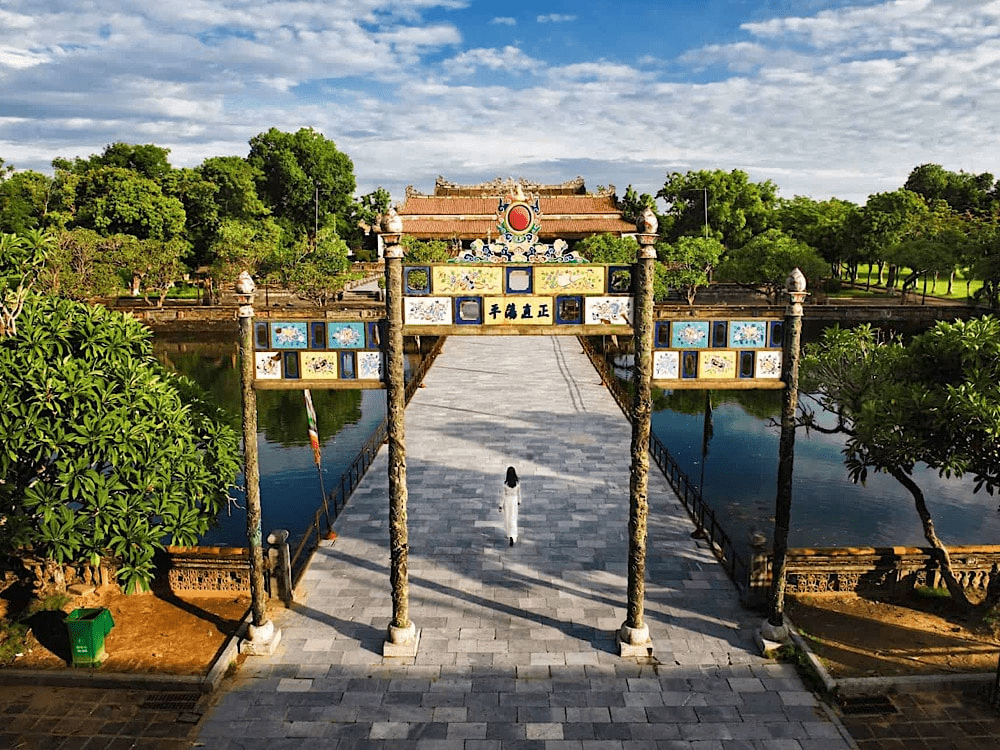
Hue has a typical tropical monsoon climate, with two main seasons: the rainy season and the dry season. The rainy season in Hue lasts from September to January, with heavy rainfall and humid weather, which can affect visitors’ outdoor travel plans. In particular, in the last months of the year, Hue often experiences heavy rains, sometimes accompanied by storms and floods, making historical sites and scenic spots more difficult to access.
The dry season in Hue starts from May and lasts until September. This is a sunny period, with temperatures usually ranging from 25 – 35 degrees Celsius, suitable for outdoor sightseeing and exploration activities. In particular, from January to April, Hue’s weather is most pleasant with a cool climate and little rain, ideal for visitors to stroll around the Hue Citadel, royal tombs, and other spiritual destinations. In the summer, from June to August, the temperature in Hue can rise, especially suitable for those who love the sea, but not the ideal time for long walks or outdoor sightseeing.
Hoi An Weather
Hoi An also has a tropical climate with two rainy and dry seasons, but the difference in weather in Hoi An is more pronounced and has a big impact on the travel experience. The dry season in Hoi An lasts from February to August, when the weather is warm and the sky is clear. This is considered the most ideal time to visit Hoi An ancient town, when visitors can stroll around the lantern streets, visit the Japanese Covered Bridge and famous assembly halls without worrying about the rain and wind. May and June are also the dry season, but the temperature begins to rise, which is very favorable for beach activities and outdoor activities, but can cause a feeling of heat at noon.
The rainy season in Hoi An starts from August and lasts until January of the following year. During this time, Hoi An often has heavy rains, and some areas may be affected by flooding, especially the old town and the Thu Bon River area. Heavy rains limit sightseeing and travel activities, and affect the experience when tourists want to explore traditional craft villages or enjoy the sparkling ancient town under the lights. Therefore, the rainy season is not the most favorable time to visit Hoi An, unless tourists want to experience a different Hoi An.
Should I choose to travel to Hoi An or Hue?
Central Vietnam is home to many famous landscapes and cultural heritages, of which Hoi An and Hue are two prominent destinations. Each place has its own unique characteristics, meeting the different needs and interests of tourists. So should you choose to travel to Hoi An or Hue? Let’s find out the unique features of each place to make the right choice for your trip.
Hoi An – A romantic and peaceful destination
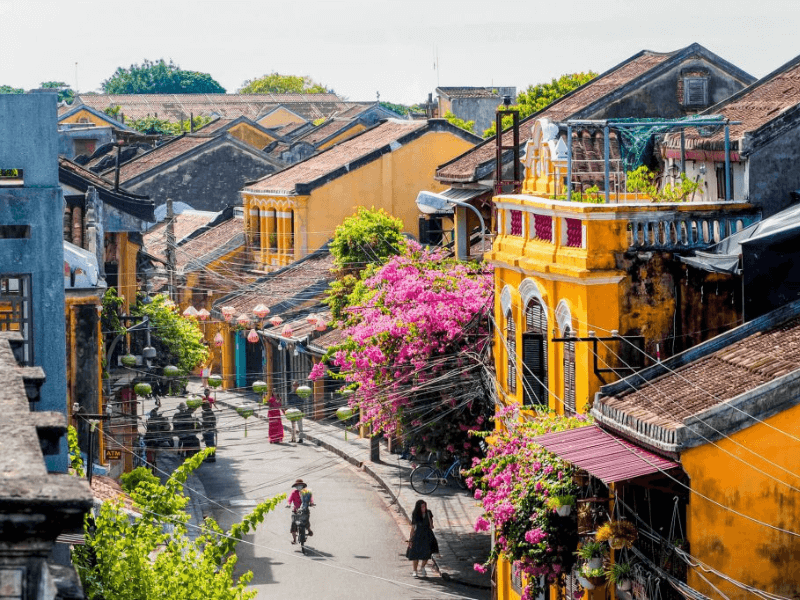
If you are a lover of quiet and romantic spaces, Hoi An will definitely be the ideal choice. Hoi An ancient town is famous for its small streets, lined with ancient houses with old tiled roofs, lit up in lanterns at night. The beauty of Hoi An is not too sophisticated, but brings a gentle, relaxing feeling, very suitable for couples and families who want to have moments of relaxation and rest. The peaceful scenery along the Thu Bon River and the quiet atmosphere of the ancient town are the reasons why many people love Hoi An.
Hue – For those who are passionate about culture and history
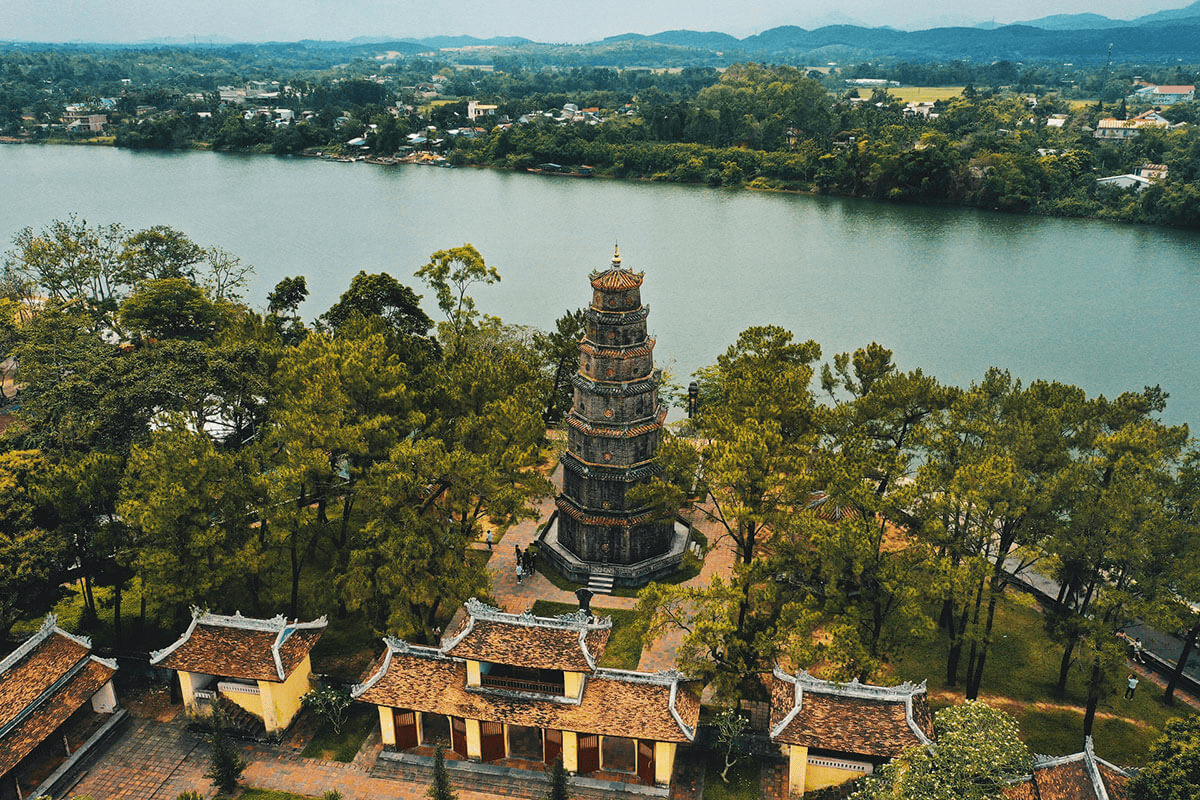
In contrast to the tranquility and romance of Hoi An, Hue is an ideal place for those who love to explore history and culture. Once the ancient capital of Vietnam, Hue still retains its ancient atmosphere with many valuable historical relics from the Nguyen Dynasty. Constructions such as Hue Citadel, royal tombs and majestic temples not only demonstrate architectural talent but also contain profound historical values, which are invaluable cultural heritages of the nation.
Thus, choosing Hoi An or Hue depends on your preferences and purpose of the trip. If you want to enjoy the quiet, romance, and immerse yourself in a gentle space, Hoi An ancient town is the perfect choice. This place is suitable for couples and families, those who seek relaxation and tranquility in an ancient space.
On the contrary, if you are passionate about history, love to explore and want to understand more about Vietnamese culture, Hue will be the ideal destination. With impressive historical relics and unique royal culture, Hue is the place for you to learn about the past of a golden age, feel the majesty and solemnity of an ancient capital.
Whether choosing Hoi An or Hue, both destinations offer visitors unique experiences and unforgettable memories. Choose the destination that best suits your soul and expectations, or even plan to explore both places to have a complete view of the beauty of Central Vietnam.
If you choose Hoi An as your destination for your upcoming trip, please refer to the accommodation address we recommend. Bliss Hoi An Beach Resort & Wellness is truly an ideal choice for those who are looking for a peaceful and complete vacation in Hoi An. With a beautiful location near the beach, high-class health care services, and sophisticated design space, this place not only brings absolute relaxation but also helps visitors have memorable experiences. If you are planning a trip to Hoi An, let Bliss Hoi An Beach Resort & Wellness be the ideal stopover, where you can immerse yourself in the natural beauty and recharge your energy. Surely, this will be an unforgettable memory in your journey to explore Hoi An!

